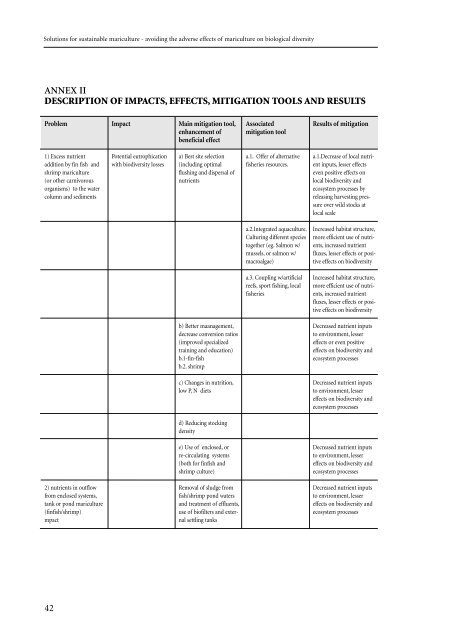Solutions for sustainable mariculture - Convention on Biological ...
Solutions for sustainable mariculture - Convention on Biological ...
Solutions for sustainable mariculture - Convention on Biological ...
- No tags were found...
Create successful ePaper yourself
Turn your PDF publications into a flip-book with our unique Google optimized e-Paper software.
<str<strong>on</strong>g>Soluti<strong>on</strong>s</str<strong>on</strong>g> <str<strong>on</strong>g>for</str<strong>on</strong>g> <str<strong>on</strong>g>sustainable</str<strong>on</strong>g> <str<strong>on</strong>g>mariculture</str<strong>on</strong>g> - avoiding the adverse effects of <str<strong>on</strong>g>mariculture</str<strong>on</strong>g> <strong>on</strong> biological diversityANNEX IIDESCRIPTION OF IMPACTS, EFFECTS, MITIGATION TOOLS AND RESULTSProblemImpactMain mitigati<strong>on</strong> tool,enhancement ofbeneficial effectAssociatedmitigati<strong>on</strong> toolResults of mitigati<strong>on</strong>1) Excess nutrientadditi<strong>on</strong> by fin fish andshrimp <str<strong>on</strong>g>mariculture</str<strong>on</strong>g>(or other carnivorousorganisms) to the watercolumn and sedimentsPotential eutrophicati<strong>on</strong>with biodiversity lossesa) Best site selecti<strong>on</strong>(including optimalflushing and dispersal ofnutrientsa.1. Offer of alternativefisheries resources.a.1.Decrease of local nutrientinputs, lesser effectseven positive effects <strong>on</strong>local biodiversity andecosystem processes byreleasing harvesting pressureover wild stocks atlocal scalea.2.Integrated aquaculture.Culturing different speciestogether (eg. Salm<strong>on</strong> w/mussels, or salm<strong>on</strong> w/macroalgae)Increased habitat structure,more efficient use of nutrients,increased nutrientfluxes, lesser effects or positiveeffects <strong>on</strong> biodiversitya.3. Coupling w/artificialreefs, sport fishing, localfisheriesIncreased habitat structure,more efficient use of nutrients,increased nutrientfluxes, lesser effects or positiveeffects <strong>on</strong> biodiversityb) Better maanagement,decrease c<strong>on</strong>versi<strong>on</strong> ratios(improved specializedtraining and educati<strong>on</strong>)b.1-fin-fishb.2. shrimpDecreased nutrient inputsto envir<strong>on</strong>ment, lessereffects or even positiveeffects <strong>on</strong> biodiversity andecosystem processesc) Changes in nutriti<strong>on</strong>,low P, N dietsDecreased nutrient inputsto envir<strong>on</strong>ment, lessereffects <strong>on</strong> biodiversity andecosystem processesd) Reducing stockingdensitye) Use of enclosed, orre-circulating systems(both <str<strong>on</strong>g>for</str<strong>on</strong>g> finfish andshrimp culture)Decreased nutrient inputsto envir<strong>on</strong>ment, lessereffects <strong>on</strong> biodiversity andecosystem processes2) nutrients in outflowfrom enclosed systems,tank or p<strong>on</strong>d <str<strong>on</strong>g>mariculture</str<strong>on</strong>g>(finfish/shrimp)mpactRemoval of sludge fromfish/shrimp p<strong>on</strong>d watersand treatment of effluents,use of biofilters and externalsettling tanksDecreased nutrient inputsto envir<strong>on</strong>ment, lessereffects <strong>on</strong> biodiversity andecosystem processes42
















